Clean Power at a Steep Price
Extracting the lithium that EVs need could destroy this rare desert ecosystem in Chile
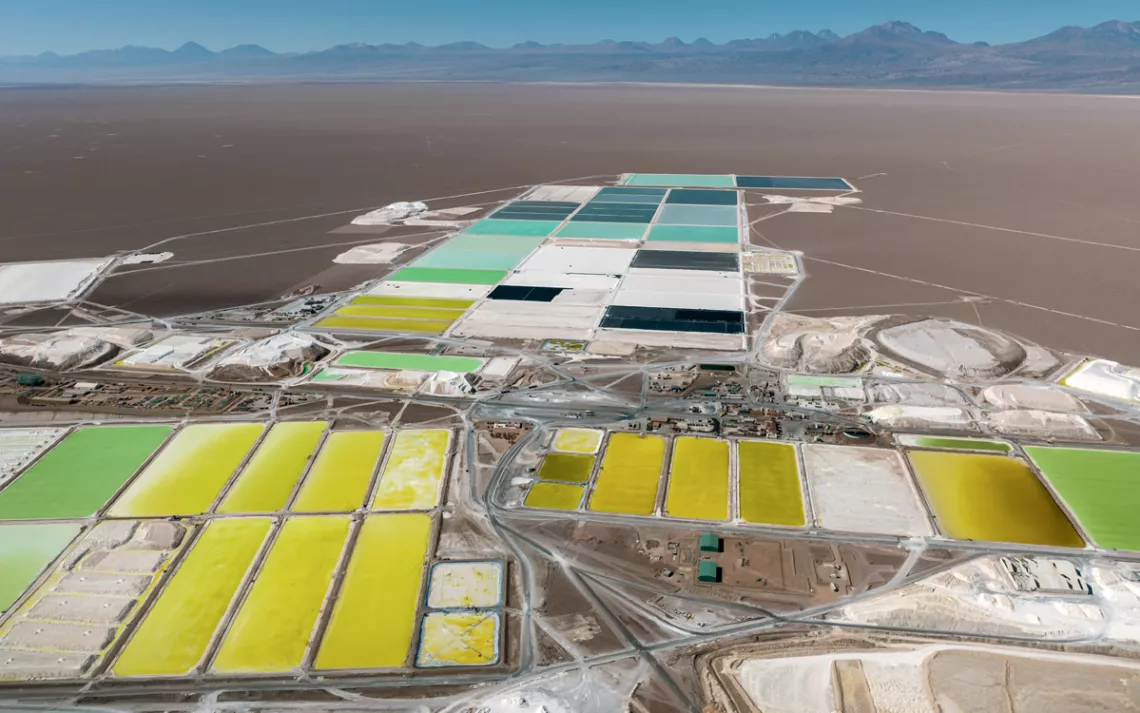
Albemarle's lithium-mining operation in the Atacama Desert, Chile. | Photo by John Moore/Getty Images
DEEP IN THE ATACAMA Desert of northern Chile, the sun beats down on hundreds of enormous, shallow rectangular ponds. The ponds, covering more than 17 square miles, are a patchwork of blues, greens, and yellows, like fabric swatches laid out by Godzilla looking to reupholster his couch. Technically, this is a mine—an industrial operation extracting tons of metal from beneath the ground. But there are no diesel-spewing drills, clanking conveyor belts, or even miners anywhere in view. It's quiet where I'm standing beside a teal-colored pool in the middle of the complex. The only sounds are the rumble of distant trucks and the ambient thrum of pumps pulling up mineral-rich brine from under the desert floor. Most of the extraction is performed silently, even gently, with nothing but sunshine and gravity working to slowly evaporate the water in the pools, concentrating it down to an oily yellow-green broth dense with one of the 21st century's most important resources: lithium.
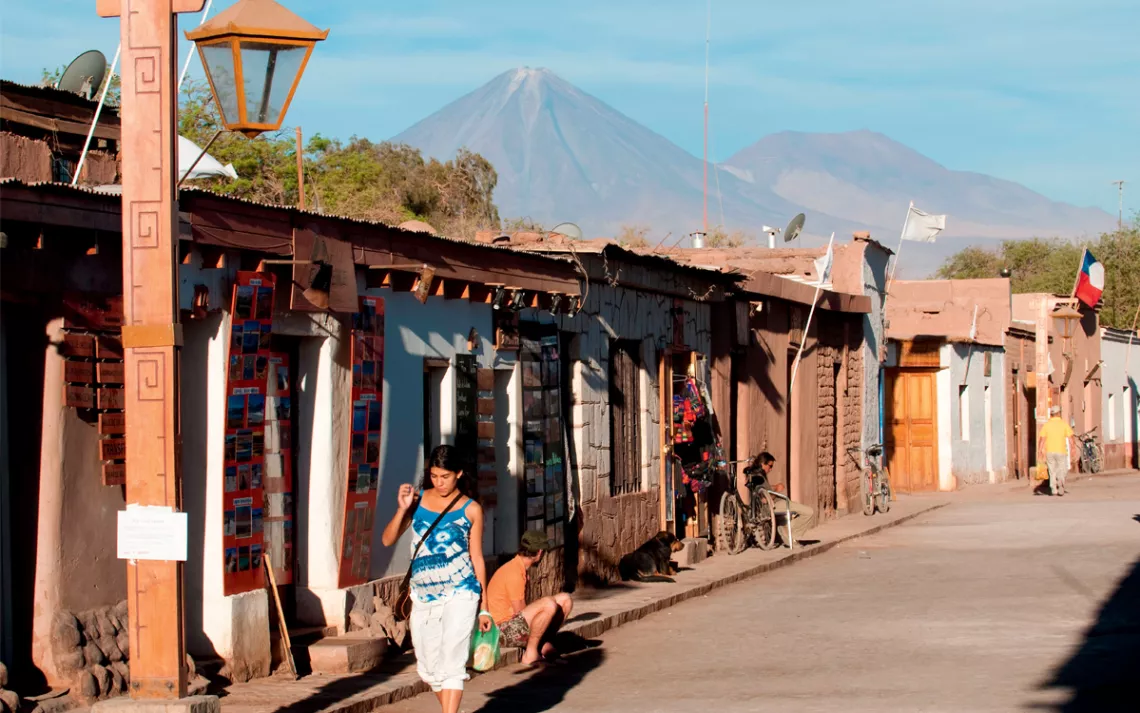
The town of San Pedro de Atacama. Lithium mines in the region provide a lot of jobs, but Atacameños fear for their tenuous water supply. | Photo by Mike Crane/Alamy Stock Photo
"The process is totally natural," says Alejandro Bucher, the cheery media rep for SQM, the bigger of the two companies currently mining lithium in the Atacama, as he tours me around the facility on a pleasantly warm day in March. "We do not add anything to the brine. There are no chemicals involved whatsoever. It's very, very clean."
It seems a fitting method to extract a substance that is critical for the transition to "green" energy. Lithium is a key ingredient in the batteries that power cellphones, laptops, and almost all electric vehicles. As the shift from fossil-fuel-powered cars to electric models accelerates, so does the world's need for lithium. Its price has more than doubled since 2020, and we're just getting started. According to International Energy Agency projections, the world needs to increase lithium production 42-fold in the next two decades if we are to bring down carbon dioxide pollution enough to stave off the worst impacts of climate change.
The Atacama plays a central role in that ramp-up, as it holds the world's largest known lithium reserves and currently accounts for a quarter of global production. But while the mines are helping save the planet, they may also be killing the Atacama. The mines suck up huge amounts of water in what is already one of the driest places on Earth. The result, according to independent researchers and many of the Atacama's Indigenous people, is that the precious underground water is disappearing, along with lagoons full of rare flamingos; vegetation that feeds goats, sheep, and llama-like guanacos; and an Atacameño way of life followed by communities for thousands of years.
It's an increasingly familiar dilemma: Extracting the metals and minerals we need to avoid the worst catastrophes of climate change creates a different set of catastrophes. In Indonesia, rainforests are being razed for nickel. In the Democratic Republic of the Congo, children toil in cobalt mines. And lithium extraction sows havoc the world over. Brine operations in Argentina have reportedly contaminated streams that irrigate food crops. Leaks from Chinese hard-rock lithium mining turned a river so toxic that it killed not only fish but also the cows and yaks that drank from it. Last January, a proposed lithium mine in Serbia was scrapped in the face of ferocious street protests. Native American tribes, ranchers, and environmental activists are fighting an enormous hard-rock operation slated to open soon at Thacker Pass, Nevada, arguing that it will desecrate sacred Indigenous lands and clobber the local ecosystem.
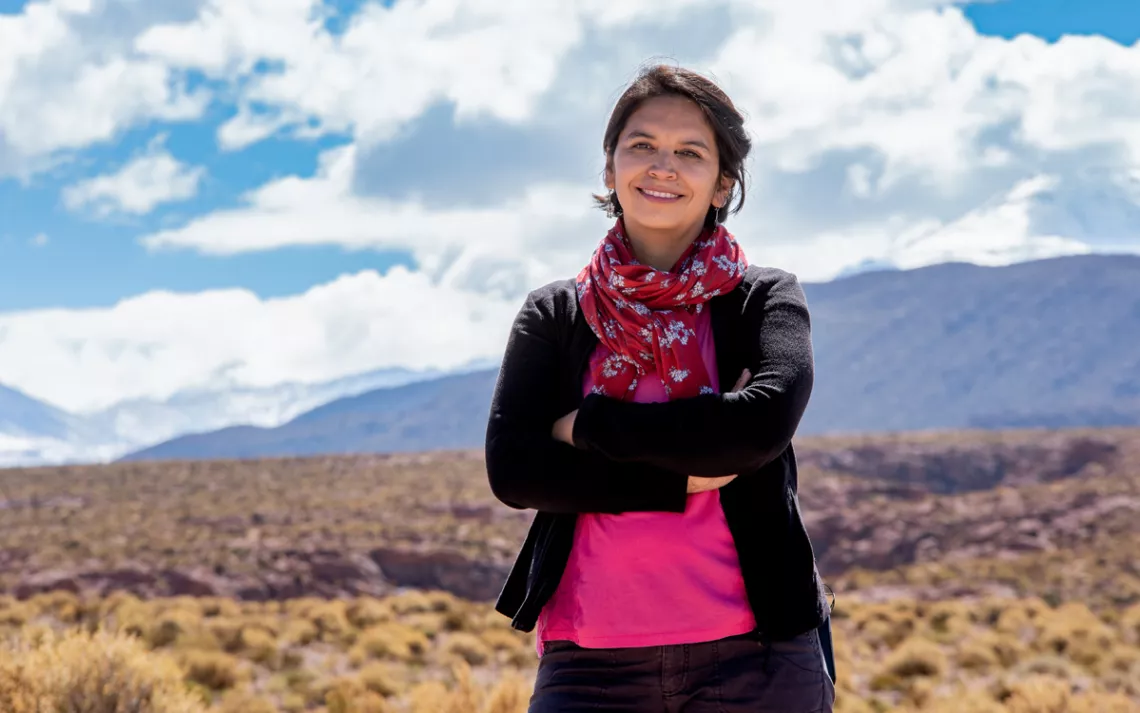
Chilean microbiologist and national assembly member Cristina Dorador, who tried to codify protections for the Atacama in a new Chilean constitution. | Photo by Rodrigo Maluenda
But we need to get the stuff from somewhere. So the question is, how can we save ourselves from climate change without destroying places like the Atacama?
MOST OF THE ATACAMA is utterly sere and barren, all rock or sand or salt flat, painted in muted reds and browns. It's so like the surface of Mars that NASA trials its rovers there, so otherworldly that episodes of The Mandalorian have been filmed there.
And yet, it sustains life. The Atacameño people have called it home for at least 12,000 years. The desert is strewn with enormous pictographs etched into stone by their ancestors and the ruins of ancient fortresses called pukaras. Today, a handful of Atacameño villages dot the foothills to the east of the lithium mines. They are mostly tucked into ravines that channel rain and snowmelt from the Andes, ribbons of greenery lush with tamarugo trees, tall grasses, and fields of corn, tomatoes, and other crops. The villagers depend on those streams and the underground aquifers they feed.
The mines sit in a huge salt flat—a salar in Spanish—miles from the nearest village. Beneath it lies an enormous reservoir of brine thick with salts, minerals, and metals, including lithium, that have accumulated over thousands of years. Underground, the fresh and salty water bodies meet in a "mixing zone" that forms a kind of border between them. The denser, heavier brine pushes the lighter freshwater toward the surface, where it forms shallow, brackish lagoons that are home to tiny brine shrimp and other micro life-forms as well as the flamingos that eat them.
The mines slurp up water both sweet and salty. They pipe in freshwater for their employees to drink and wash with and to clean equipment. And they pump brine at a rate of hundreds of gallons per second up into those colorful surface ponds, where it is left to evaporate in the sun over the course of many months. It takes more than 100,000 gallons to produce a single ton of lithium, permanently shrinking the amount of water under the desert. Engineering & Technology magazine estimated that between 1985 and 2017, some 114 billion gallons were lost to the environment of the Salar de Atacama due to brine evaporation from one lithium company alone.
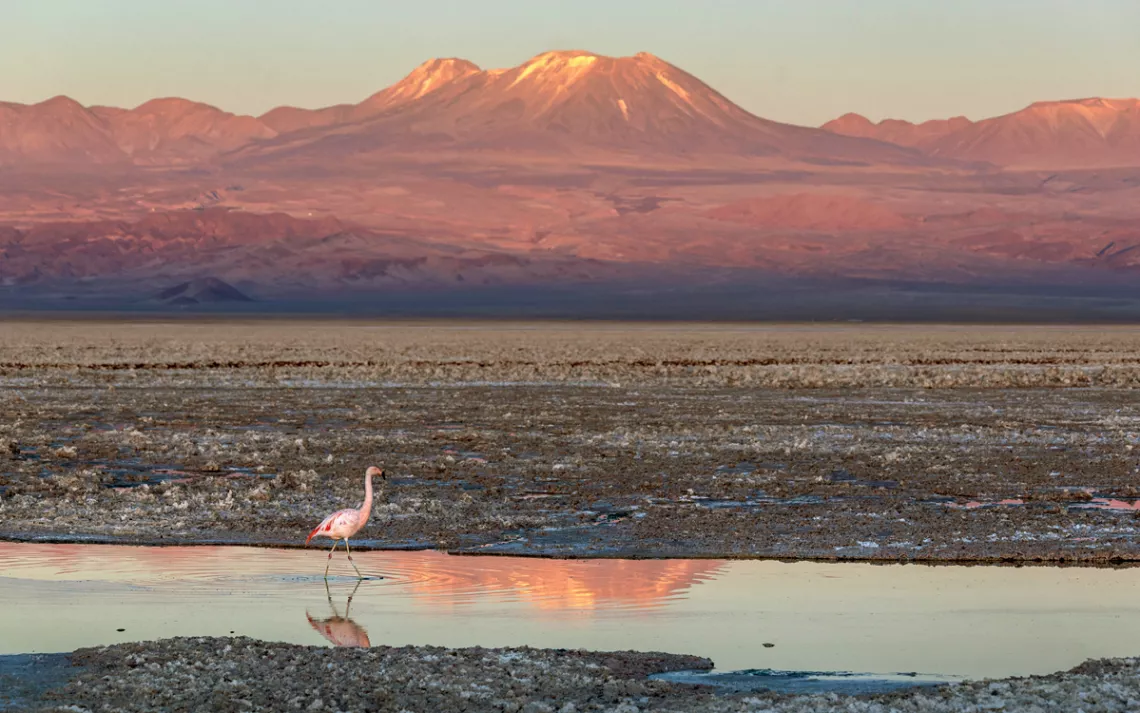
A threatened Chilean flamingo in Los Flamencos National Reserve. The birds owe their pink coloration to pigments from the brine shrimp that thrive in the region's pools. | Photo by John Moore/Getty Images
SQM's position is, essentially, that none of this matters. The freshwater it takes out "has no material impact on the water reserved for drinking and agriculture in the neighboring communities," declares an official company report. The vast quantity of brine SQM pumps, it maintains, doesn't affect the freshwater aquifer or the lagoons it supports. The brine itself "has no environmental value," said Corrado Tore, an SQM hydrogeologist who explained the process to me the day I visited the lithium mine; it's far too salty to drink or even irrigate plants. SQM's scientists maintain a network of hydrogeological sensors that track water levels and also monitor the health of the lagoons, vegetation, and wildlife via field studies and satellite imagery. The bottom line, according to the company: Its mines are not harming the Atacama ecosystem.
NOT ONE OF THE many Atacameños I spoke with—including one who has worked for the company for many years and others who work for SQM-funded organizations—believes that. They all told me the lithium mines are taking too much water and endangering everything that depends on it.
Water is an especially touchy issue in a region where sometimes the taps in villages run dry and water has to be trucked in. Atacameño worries are not eased by accusations from both SQM and United States–based Albemarle, another lithium mining outfit in the Atacama, that the other company is extracting more brine than legally allowed. A 2016 audit by Chile's environmental regulator found that SQM was indeed overdrawing brine and forced it to cut back. Albemarle may be next: The Chilean government filed a lawsuit against the company in April, accusing it of overextracting aquifer water.
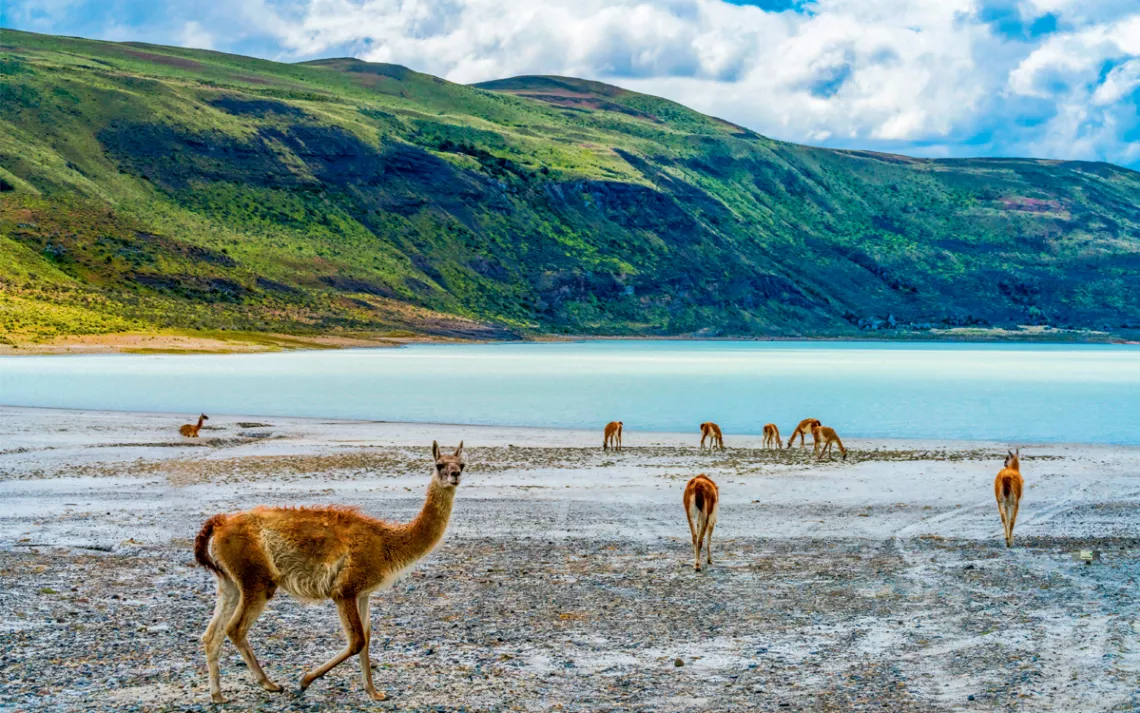
Wild guanacos—camelids closely related to llamas—in the Atacama. | Photo by agefotostock/Alamy Stock Photo
The mining companies do provide jobs and make cash payments to local communities, and sometimes fund projects like the small solar farm and water-purification plant in one of the villages, which Bucher was pleased to show me. I asked Manuel Salvatierra, the president of the Atacameño council, whether, on balance, the mines have been good or bad for his people.
"They've been really bad," he said. "There's less forage for our herds. Our agriculture is dying because there's not enough water for our crops." We were sitting at a plastic table in the courtyard of a small local hotel. Splayed in front of Salvatierra were his cellphone, an iPad, and three USB sticks on a keychain. "I have a cellphone. I use lithium too. We understand that it may be the solution," he said. "But the way they are getting it is not right. We are being made a sacrifice zone."
Salvatierra's predecessor is Sergio Cubillos, a young activist and long-standing thorn in the side of the mining companies. He has helped organize protests, petitions, a blockade, and a six-day hunger strike to protest the mining. I met him in Peine, the village closest to the mines, where he lives. Most of its few hundred residents live in small homes of cinder block or cut stone. Chickens and dogs amble through the streets. The locals have mostly traded in the burros their parents kept for dusty pickup trucks, but many still graze goats and llamas in the scrub brush down at the desert's edge.
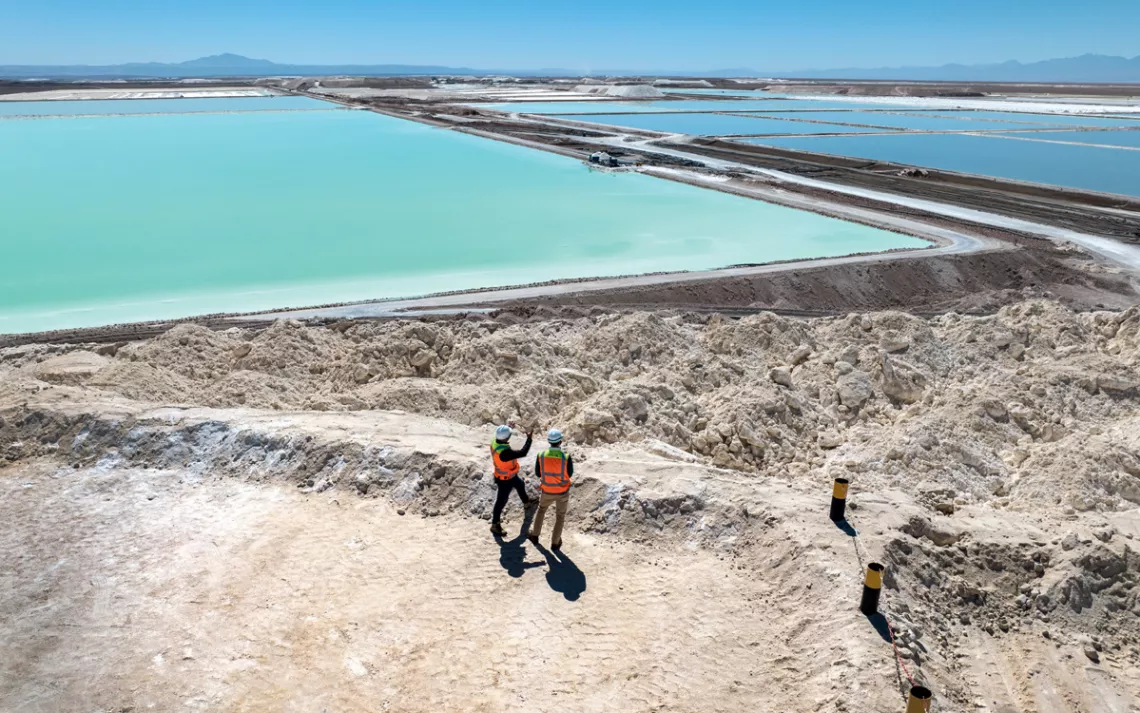
Lithium is extracted from brine via an 18-month evaporation process; the ponds turn more yellow as the lithium concentration increases. | Photo by John Moore/Getty Images
Soon after my visit to the lithium mine, Cubillos took me, my translator, and a hydrogeologist employed by the Atacameño council out to see some of the desert's little-known treasures. We set off from Peine in a four-wheel-drive truck and soon left the paved road to begin a long, bone-rattling drive over miles of rough brown-and-white salt crust unbroken by even a tuft of vegetation. Cubillos has lived his whole life in the area, but the internet and his activism have made him a man of the world. As we bounced through the desert, he chattered merrily about the shortcomings of various British soccer teams and the charms of a Canadian mountain resort where he had attended an environmental conference.
Part of Cubillos's concern for the area's water includes the cultural practices it supports. His grandparents' generation used to gather flamingo eggs to eat and exchange with other tribes, but they had to stop because there are fewer flamingos around. "There was a whole ceremony, to the land, to the water, to the flamingos themselves, to give thanks for the food," he told me. "But since the lithium companies arrived, this ancestral practice can no longer be carried out." Brine extraction, he believes, has shrunk the lagoons.
After a few hours of driving, we suddenly came upon a little hut made of cactus wood and dried cornstalks. Next to it was an exquisite pool of turquoise water, inlaid in the brown desert hardpan like a jewel. The pool was maybe 20 feet in diameter and equally deep, encircled with tall green grass. Schools of tiny fish swam in its crystal-clear depths. Brilliant-blue dragonflies flitted over its surface. A pair of hawks, displeased by our appearance, flew out of the long grass fringing the pool. A few hundred yards away, a couple of wild burros watched us. "We come here in the summer," Cubillos said. "We swim; we eat; we spend all day. The old people say the mud here is good for your skin." I can't vouch for its dermatological benefits, but to me, this tiny wetland, or vega, was an utterly unexpected reminder of how much life the desert can nurture. And how hard it is to know how much water it holds.
DESPITE HOW FIRMLY MANY Atacameños and their supporters believe that lithium mining is drying out the desert, it's very difficult to assess whether and to what extent it actually is. Rainfall and snowmelt fluctuate naturally from year to year, and so do the lagoons and their vegetation: They expand in winter, when it's cooler and wetter, and shrink in summer. Climate change is also making the region hotter and drier. That makes it tough to get a fix on the overall trend over time, and what role the mines play. "We don't have long-term baseline studies," said Cristina Dorador, a Chilean microbiologist who has been researching life in the Atacama's salt flats for the past two decades. "That makes it complicated."
There is another variable, said Felipe Lerzundi, who oversees environmental issues for Peine: "We have the impacts of the copper mines added to the impacts of lithium mines." The region is cratered with some of the planet's biggest copper mines, which suck up even more water than the lithium mines. (Chile is the world's biggest producer of copper, another key ingredient in electric vehicles.) Just last year, the Chilean government ordered Australian multinational BHP, owners of the titanic Escondida copper mine, to pay $93 million for years of overdrawing water in the Atacama. BHP has since switched to pumping in desalinated seawater, but, Lerzundi said, "we'll see the effects continue here for another 100 years."
Much of the data about water in the Atacama is gathered by the mining companies, so it's no surprise that many people don't trust it. A number of independent studies, however, suggest that lithium mines are straining freshwater supplies.
A 2019 Arizona State University study found that soil moisture and vegetation in the salt flats declined between 1997 and 2017, a period during which the lithium mines quadrupled in size. "The expanding lithium industry may be one of the important environmental stressors to the overall health of the local environment," the researchers concluded. An earlier study by a Chilean government agency found that almost a third of the drought-tolerant algarrobo trees on SQM's property were dying, possibly indicating that their roots could no longer find water. A 2018 government study found that more water was leaving the salar through pumping and evaporation than was being replaced by rain and snowfall, causing the levels of some wells to drop.
The Atacameños are using some of the cash the companies give them to conduct their own research. The council has in recent years installed sensors to monitor soil and water conditions, gathered satellite imagery, and hired independent researchers. One of them is Javier Escudero Quispe, the hydrogeologist who accompanied us on our tour. He's from the Aymara Indigenous community, a northern neighbor of the Atacameños, and is part of a team investigating whether the lagoons are being affected by brine extraction. "Normally, geologists work for the miners. But that's not my values," he said. When the opportunity to work on this project arose, he signed on eagerly and moved out to the desert. "I love the tranquility of this place," he said.
After our visit to the vega and another hour or so of jolting over the hardpan, Quispe directed us to one of the lagoons his team is studying. We arrived at a place that looked like the surface of another planet. Glimmering under the desert sun, the lagoon was a vast expanse of shallow water as clear as glass. All around its shoreline was a thick crust of what looked like ice but was actually solid salt. There was a faint tang of it in the air. Except for a light wind ruffling the lagoon's surface and the salt crunching under our feet as we walked toward the water, the place was completely silent. Then a flamingo rose from the lagoon as we approached, flapping off to the far shore to confer with a couple of colleagues.
The only signs of human life were occasional little pipes sticking up out of the water, sensors Quispe's team had planted to track the lagoon's level and temperature. The team also collects imagery of the lagoons with drones and from satellites. They were still analyzing their data at the time of my visit, but Quispe was confident that their findings will indicate that the lagoons are fed not only with freshwater pushed upward in the mixing zone but also with water from the brine reservoir. (Such findings would echo a 2019 analysis by Engineering & Technology. A 2022 study by researchers from Chile, Spain, and the US also found surface water—including the lagoons—has declined in the Atacama in recent years.)
That means, Quispe said, that taking too much brine for the lithium mines could impact the lagoons. "This ecosystem is in a very delicate balance. If you disturb it, you can destabilize the whole system," he said. "It could mean less food for the flamingos. With less food, some will die." A 2022 study found that the number of flamingos in the Salar de Atacama has declined over the past three decades. It seems they are mostly moving to other lagoons in an area straddling Chile, Argentina, and Bolivia.
Bucher said SQM's own research shows that flamingo populations are fluctuating within a natural range and that, overall, the lagoons have not changed in size or depth. Still, climate change is making the whole region hotter, and both SQM and Albemarle plan to expand operations in the coming years. Other companies are also exploring lithium prospects in the Atacama.
"What makes me anxious is if they allow more extraction," said Alejandra Castro, a ranger at Chile's national flamingo reserve who helps run regular counts of the birds. That, she fears, "could cause an irreversible reduction in the flamingo population."
ROD COLWELL THINKS THERE'S a better way to pull lithium from subsurface brine, and he's spent more than a decade in a different desert trying to prove it. Colwell heads a start-up called Controlled Thermal Resources that's based 100 miles east of San Diego, California, in creosote-stubbled Imperial County, near the human-created Salton Sea. There, a reservoir a mile beneath the surface seethes with scalding-hot brine rich with dissolved lithium. (The Atacama's brine is much closer to the surface and not nearly as hot.) The area's briny heat has been tapped for geothermal power since the 1980s, but only now are companies starting to extract the white metal.
Colwell is from Australia, which was immediately obvious from his "g'day mate" accent. He's been in Imperial County since 2011, working to get at that lithium—raising money, schmoozing local politicians, and answering questions from regulators and concerned locals. "Our challenge is getting it permitted, getting it built, and getting it out of the ground," he said. "The demand is already there. We could sell 200,000 tons a year right now, just to Detroit automakers."
This year, he is finally seeing tangible results. From the top of a red dirt hill about a mile from the Salton Sea, Colwell pointed out a drilling rig that came online in December 2021. It bores down some 8,000 feet to tap into the 600°F brine and bring it to the surface, where its heat is converted into geothermal energy and its lithium extracted. The mining operation is in the final stages before commercial production—what Colwell believes could be a nearly $1 billion business that will, starting in 2024, produce some 25,000 metric tons of lithium per year, ramping up from there.
Rather than letting the water evaporate as in the Atacama process, the company plans to extract the lithium via an adsorption process. The leftover saltwater will then be pumped back underground, and the whole apparatus will be powered with near-zero-carbon geothermal energy. Taken together, Colwell said, that means Controlled Thermal's system will take up far less space and use much less water than the Atacama operations. And unlike conventional hard-rock lithium mining—at Nevada's Thacker Pass, for example—its operation won't involve gouging enormous holes in the earth and will generate little in the way of toxic waste and carbon emissions.
It's an attractive vision. General Motors and Stellantis (the parent company of Chrysler, Fiat, and other automakers) have already signed deals to buy Controlled Thermal's lithium. So has an Italian company that plans to build a $4 billion battery factory in the area. Other companies, including Berkshire Hathaway subsidiary BHE Renewables, are also moving ahead with pilot lithium-extraction projects at geothermal plants by the Salton Sea. All of which has in recent years gotten excitable boosters, including California governor Gavin Newsom, to start dreaming out loud about developing the area into a lucrative "Lithium Valley."
The chronically impoverished region could sure use some new jobs. Brawley, the biggest of the farming towns near the geothermal fields, is a somnolent place; many of the buildings on Main Street are empty or boarded up. What must have once been a charming old movie theater is long closed, its paint faded thin and pale.
Even so, some local leaders are skeptical. "At the end of the day, we all want good businesses, clean businesses, sustainable businesses. But we've been burned many times before," said Luis Olmedo, a longtime community advocate. Everyone around here remembers when solar power companies moved in, promising jobs and prosperity. "They took thousands of acres of farmland that had provided jobs for 100 years," Olmedo said. "The construction companies came in, built the plants, and were gone"—along with those farming jobs.
No one can say whether Controlled Thermal or the other Imperial Valley lithium miners will succeed (others have tried and failed, and Colwell acknowledges that the Atacama mines will still produce lithium more cheaply). And nobody knows what unforeseen impacts they may have in the long run. The area may very well add some more-sustainable lithium into the global mix. That would be helpful but insufficient—we'll still need the Atacama's lithium for many years to come.
BACK IN CHILE, the years of protests, public pressure, and bad press are taking a toll. SQM, Bucher promises, is changing its ways to keep up with the times. Sustainability is now a top company priority, he says. It's not only the right thing to do; it's a market imperative. SQM's customers are demanding it. Many are certainly aware that it's an issue they need to at least appear to be addressing: Volkswagen, Mercedes-Benz, and BMW have all signed on to a recently established partnership aimed at supporting "responsible" lithium mining in the Atacama.
In response, SQM has released a sustainability plan that includes pledges to make its operations more transparent, improve relations with nearby communities, and become carbon neutral by 2040. (The mine currently draws power from a coal-fired plant.) It's also trying to get a stamp of approval from the Initiative for Responsible Mining Assurance, a US-based nonprofit headed by a veteran critic of the industry that audits conditions at mines around the world.
Perhaps most important, SQM promises to slash its water use by 2030 (which just happens to be the year when its lithium concession comes up for renewal). Bucher says the mine has already cut freshwater consumption in half from pre-2020 levels and will also reduce brine pumping. It can do that without diminishing production, he says, with efficiency-enhancing techniques like pumping from areas that have higher lithium concentrations.
Such measures can help, but to Dorador the microbiologist, they're not enough. "Lithium mining is not sustainable. It's a myth," she said. "The salars are complex, fragile ecosystems. Every little change can produce big damage." After years of advocacy around the Atacama, Dorador recently switched from trying to influence policymakers to becoming one herself. Last year, she got herself elected to a national assembly charged with writing a new constitution for Chile. She and others worked to enshrine potent protections for the environment, animals, and people. The proposed constitution, however, was rejected in a nationwide referendum in September.
Dorador was disappointed, of course, but she has always argued that the real problem is the sheer amount of natural resources that human beings devour. "Maintaining the same level of consumption is impossible, physically impossible," she said. "We need to change the way that we live on Earth."
For example, replacing 10 gasoline cars with 10 electric cars reduces carbon emissions, but building those new cars still requires tons of raw materials—copper, iron, rubber, and of course lithium—and the process of extracting each of them takes a toll on the environment. On the other hand, replacing 10 gasoline cars with public transport or bicycles reduces impacts across the board.
Similarly, we could direct less energy and capital into digging up virgin minerals and metals and more into recycling those that are already aboveground. Currently, we recover more than half the cobalt and nickel we use worldwide but less than 1 percent of the lithium. Recycling lithium batteries could reduce the need for new mining. Materials scientists are currently developing and streamlining the recycling processes, funded by both national governments and private companies.
The business-as-usual approach—swapping a personal EV for every internal-combustion vehicle, getting a new smartphone every year—is asking the Atacameños and others like them who did almost nothing to create the climate crisis to bear a heavy cost to fix it. True, the Atacameños' traditional practices linked to the desert's water—nursing crops, herding animals, swimming in the vegas—are now practiced by only a very small number of people. But they are traditions that have been followed for longer than history records. Their disappearance would break a chain that stretches back 12,000 years.
Likewise, the deserts' lagoons and vegas and flamingos are relatively few and of no great importance to the global economy. But they are unique. If they disappear, they will never return.
We've already lost so many ancient traditions and unique natural places to the frenzied development of the modern world. Almost certainly, the shift to renewable energy will sacrifice still more. Ironically, our efforts to heal the planet will inevitably also harm it. The challenge we face is how to avoid inflicting most of that harm on the blameless.
Support for this article was provided by the Pulitzer Center on Crisis Reporting and the Canada Council for the Arts.
 The Magazine of The Sierra Club
The Magazine of The Sierra Club



